
DATAMATH CALCULATOR MUSEUM
 |
DATAMATH CALCULATOR MUSEUM |
The official introduction of the TI-2500 Datamath portable calculator and the desktop models TI-3000 and TI-3500 dates back to September 21, 1972. The three calculators used different display technology:
• The TI-2500 portable electronic calculator
a red 8-digit Light-Emitting-Diode (LED) display
• The desktop
models an orange gas-discharge displays with either 8 or
10-digits marketed by Burroughs as Panaplex™
display.
Main disadvantage of these technologies was their high power consumption, later calculators like the TI-1750 used Liquid-Crystal-Displays (LCD). The first LCD used yellow polarization filters to damp the ultraviolet radiation of the sunlight, later calculators like the TI-25 used transparent filters. One step between the LED and LCD marked the TI-1025 with its green Vacuum-Fluorescent Display (VFD).
![]() The Light-Emitting-Diode itself was invented in the mid-1960s
by the US company Monsanto and marketed together with Hewlett Packard. Read more
about the early days of the LED here. Later
manufacturers of seven-segment displays for electronic calculators included
Dialight, Fairchild, Litronix, Motorola and Texas Instruments.
The Light-Emitting-Diode itself was invented in the mid-1960s
by the US company Monsanto and marketed together with Hewlett Packard. Read more
about the early days of the LED here. Later
manufacturers of seven-segment displays for electronic calculators included
Dialight, Fairchild, Litronix, Motorola and Texas Instruments.
Texas Instruments introduced together with the first single-chip calculator IC TMS0100 a multi-digit display specially designed for calculators like the TI-2500 Datamath based on that chip. The TIL360 is a common-cathode display mounted in a red plastic package with as many as 6 digits per package. The height of each digit is 1/10 of a inch.

Two variations, the DIS40 and the DIS95, are of special interest for calculators:
• The DIS40 contains five digits, from left to right they are digit, blank, digit,
digit, digit, digit.
• This display will be used for the four most significant
digits on the display and for the negative sign and error/overflow indication.
The DIS95 contains four digits, from left to right they are digit, digit, digit,
digit, blank, blank.
This display will be used for the four least significant
digits of the display.
The package is designed such that when two or more packages are mounted end-to-end as shown in the above picture the character spacing is constant. This feature allowed the formation of a numeric display with sign, overflow, decimal and any number of characters.
The following calculator generation manufactured by Texas Instruments like the SR-11 or SR-50 used single digit modules with a cylindrical plastic lens to enhance the readability. The next picture taken from a SR-50 gives you an idea of the architecture of the complete display. The lens is removed for better visibility:
 Each of these
14 TILxxx modules contains a complete seven-segment LED display with decimal
point in a red plastic housing. The top of the display is formed like a bubble
lens to give a larger appearance of the characters.
Each of these
14 TILxxx modules contains a complete seven-segment LED display with decimal
point in a red plastic housing. The top of the display is formed like a bubble
lens to give a larger appearance of the characters.
It is obvious that these technologies are quite expensive. In a first step the
chip 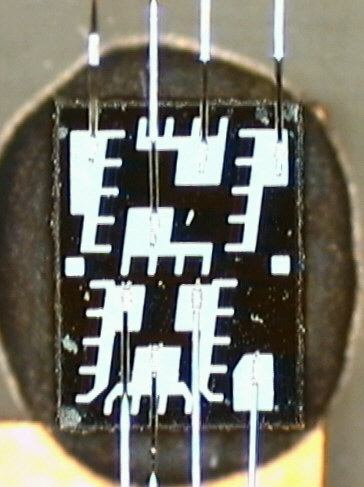 of
the seven-segments display has to be bonded to the lead frame, packaged and
tested. In a second step the display modules were soldered on the printed
circuit board (PCB) of the calculator. As a logical consequence the US company
Bowmar/ALI introduced the so-called Opto-stick, a small PCB with the
seven-segment chips directly bonded on it. Texas Instruments evaluated this
cost-effective technology with the TI-2500B
calculator and adopted it for later calculators like the TI-1200.
The picture on the right shows one of the seven-segment chips found under the
plastic lenses.
of
the seven-segments display has to be bonded to the lead frame, packaged and
tested. In a second step the display modules were soldered on the printed
circuit board (PCB) of the calculator. As a logical consequence the US company
Bowmar/ALI introduced the so-called Opto-stick, a small PCB with the
seven-segment chips directly bonded on it. Texas Instruments evaluated this
cost-effective technology with the TI-2500B
calculator and adopted it for later calculators like the TI-1200.
The picture on the right shows one of the seven-segment chips found under the
plastic lenses.
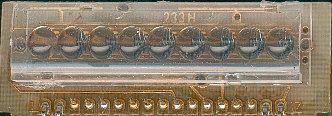 The 8-digit
LED-stick on the left is taken from a TI-1200 and was manufactured in Taiwan.
Other calculators used 6-digits or even 12-digits like the SR-51-II.
Please notice the huge bubble-lens molded in the plastic cover above the
LED-chips.
The 8-digit
LED-stick on the left is taken from a TI-1200 and was manufactured in Taiwan.
Other calculators used 6-digits or even 12-digits like the SR-51-II.
Please notice the huge bubble-lens molded in the plastic cover above the
LED-chips.
The LED-sticks were soldered with wires to the main printed circuit board of the
calculator. Moving to the real single-chip calculators without any other
components like display-drivers or even resistors and capacitors created the TI-30
architecture:
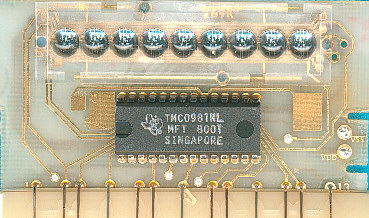 The LED-stick
and the calculator chip formed one small unit mounted behind the red viewing
window of the calculator. This PCB was connected to a simple keyboard forming a
8*5 matrix and a battery.
The LED-stick
and the calculator chip formed one small unit mounted behind the red viewing
window of the calculator. This PCB was connected to a simple keyboard forming a
8*5 matrix and a battery. 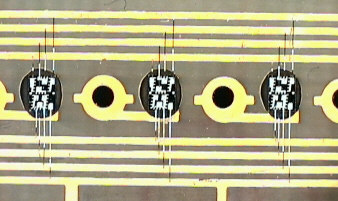
The picture on the right shows three of the nine seven-segment chips under the
bubble-lens. You will notice again the common-cathode technology of the display.
All segments are wired in parallel (the horizontal traces) and the digits
multiplexed or scanned (the through-hole connections) from the calculator chip.
The LED technology started with the Datamath in the year 1972 eclipsed roughly 5
years later with the TI-57 using the same
technology as the TI-30.
![]() The gas-discharge displays used in the desktop calculators
from Texas Instruments were manufactured by Burroughs.
Compared with the earlier Nixie tubes these Panaplex™ display use a
seven-segment structure instead of the rounded characters. The warm, neon-orange
glowing gives a very good readability even under high ambient light.
The gas-discharge displays used in the desktop calculators
from Texas Instruments were manufactured by Burroughs.
Compared with the earlier Nixie tubes these Panaplex™ display use a
seven-segment structure instead of the rounded characters. The warm, neon-orange
glowing gives a very good readability even under high ambient light.

The Panaplex II shown above uses a hermetically tight sandwich
construction filled with neon gas. Below the top glass you may recognize the
thin and nearly transparent anodes of each digit. The cathodes are printed in
thickfilm technology with a conductive material direct on the ceramics substrate.
If a voltage of typically 180 Volts is applied between a segment and its cathode,
the neon gas begins to glow. The typical current for a display with 0.55 inch
digit height is 2.5 mA. Burroughs manufactured displays with heights down to
0.25 inch.
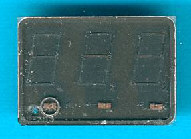 Beckman
(later absorbed into Sperry
Information Display Division, Scottsdale, AZ), manufactured raised-cathode,
planar-gas-discharge displays. Units of equal character height could be stacked
horizontally to make any desired message field while maintaining continuous
inter-character spacing. One known calculator using the
SP-753
(3-digit width, 0.55 inch digit height) is the Heathkit
IC-2008.
Beckman
(later absorbed into Sperry
Information Display Division, Scottsdale, AZ), manufactured raised-cathode,
planar-gas-discharge displays. Units of equal character height could be stacked
horizontally to make any desired message field while maintaining continuous
inter-character spacing. One known calculator using the
SP-753
(3-digit width, 0.55 inch digit height) is the Heathkit
IC-2008.
Burroughs™,
Sperry™ and Panaplex™ are trademarks of Unisys Corporation.
![]() Only few
calculators manufactured by Texas Instruments used the Vacuum-Fluorescent
Display (VFD) known from most early Japanese calculators. From the technology
the VFD is very similar to the CRT of your computer or television set. It uses
three different electrodes, the grid to switch illumination on or off, the
anodes forming the segments and the filament as the cathodes.
Only few
calculators manufactured by Texas Instruments used the Vacuum-Fluorescent
Display (VFD) known from most early Japanese calculators. From the technology
the VFD is very similar to the CRT of your computer or television set. It uses
three different electrodes, the grid to switch illumination on or off, the
anodes forming the segments and the filament as the cathodes.
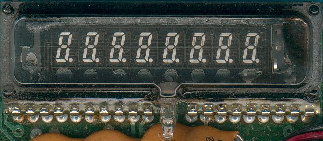 The display module
of a TI-1025 gives a good visibility
off the details. The seven segments and the decimal point of each digit are
covered with phosphorus. Above them you notice a rectangular metal mesh, the grid.
The small wires running on a horizontal path are the filament. Typical voltage
of such a small display is only 25 Volts, the larger ones need about 30 to 35 Volts at a
current of 3.85 mA. Early manufacturers of these displays are General Electric
(GE) and Tung Sol.
The display module
of a TI-1025 gives a good visibility
off the details. The seven segments and the decimal point of each digit are
covered with phosphorus. Above them you notice a rectangular metal mesh, the grid.
The small wires running on a horizontal path are the filament. Typical voltage
of such a small display is only 25 Volts, the larger ones need about 30 to 35 Volts at a
current of 3.85 mA. Early manufacturers of these displays are General Electric
(GE) and Tung Sol.
 The first
calculators using Liquid-Crystal Displays (LCDs) sold by Texas Instruments
were actually Japanese built products. The TI-1750
introduced April, 1977 was developed and produced by Toshiba. Even later
products manufactured in the Unites States like the TI-53
used Japanese displays manufactured by Epson. Main advantage of the LCD
technology is the low power consumption. Modern calculators are powered by
sunlight instead of huge battery packs or the main outlet known from the other
technologies.
The first
calculators using Liquid-Crystal Displays (LCDs) sold by Texas Instruments
were actually Japanese built products. The TI-1750
introduced April, 1977 was developed and produced by Toshiba. Even later
products manufactured in the Unites States like the TI-53
used Japanese displays manufactured by Epson. Main advantage of the LCD
technology is the low power consumption. Modern calculators are powered by
sunlight instead of huge battery packs or the main outlet known from the other
technologies.
 The LCD module on
the left, borrowed from a TI-35
gives an idea of the construction. The display uses two thin glass plates with a
small amount of liquid crystal between them. The inner side of each glass is
printed with transparent, conductive paint forming the electrodes. The upper
glass holds the segment electrodes of each digit, the lower glass the digit
electrodes. With an etching process small channels are included in one glass
giving the liquid crystals a first orientation. Together with a reflector behind
the display and a polarizing film (not shown on the picture) the LCD operation
starts. Without any voltage applied to the electrodes the ambient light will be
reflected by the silver reflector without changing the direction of the
polarization. With a small AC voltage applied the liquid crystals will rotate
the direction of the polarization and the black character will appear. Typical
displays manufactured by EPSON or OPTEL will consume less than 0.1 mA at
voltages of about 6 V to 15 Volts AC.
The LCD module on
the left, borrowed from a TI-35
gives an idea of the construction. The display uses two thin glass plates with a
small amount of liquid crystal between them. The inner side of each glass is
printed with transparent, conductive paint forming the electrodes. The upper
glass holds the segment electrodes of each digit, the lower glass the digit
electrodes. With an etching process small channels are included in one glass
giving the liquid crystals a first orientation. Together with a reflector behind
the display and a polarizing film (not shown on the picture) the LCD operation
starts. Without any voltage applied to the electrodes the ambient light will be
reflected by the silver reflector without changing the direction of the
polarization. With a small AC voltage applied the liquid crystals will rotate
the direction of the polarization and the black character will appear. Typical
displays manufactured by EPSON or OPTEL will consume less than 0.1 mA at
voltages of about 6 V to 15 Volts AC.
Datamath™ is a trademark of Texas Instruments.
If you have additions to the above article please email: joerg@datamath.org.
© Joerg Woerner, January 13, 2001. No reprints without written permission.